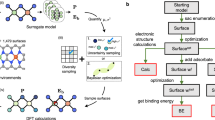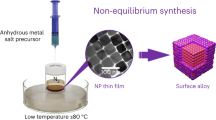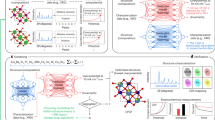Abstract
Metal oxide alloys (for example AxByOz) exhibit dramatically different catalytic properties in response to small changes in composition (the A:B ratio). Here, we show that for the ternary zinc–chromium oxide (ZnCrO) catalysts the activity and selectivity during syngas (CO/H2) conversion strongly depend on the Zn:Cr ratio. By using a global neural network potential, stochastic surface walking global optimization and first principles validation, we constructed a thermodynamics phase diagram for Zn–Cr–O that reveals the presence of a small stable composition island, that is, Zn:Cr:O = 6:6:16 to 3:8:16, where the oxide alloy crystallizes into a spinel phase. By changing the Zn:Cr ratio from 1:2 to 1:1, the ability to form oxygen vacancies increases appreciably and extends from the surface to the subsurface, in agreement with previous experiments. This leads to the critical presence of a four-coordinated planar Cr2+ cation that markedly affects the syngas conversion activity and selectivity to methanol, as further proved by microkinetics simulations.
This is a preview of subscription content, access via your institution
Access options
Access Nature and 54 other Nature Portfolio journals
Get Nature+, our best-value online-access subscription
24,99 € / 30 days
cancel any time
Subscribe to this journal
Receive 12 digital issues and online access to articles
111,21 € per year
only 9,27 € per issue
Prices may be subject to local taxes which are calculated during checkout




Similar content being viewed by others
Data availability
All the data are available within the article (and Supplementary Information) and from the corresponding authors upon reasonable request.
Code availability
The software code for LASP and the NN potentials used within the article are available from the corresponding author upon request or on the website http://www.lasphub.com.
References
Kung, H. H. Methanol synthesis. Catal. Rev. Sci. Eng. 22, 235–259 (1980).
Molstad, M. C. & Dodge, B. F. Zinc oxide–chromium oxide catalysts for methanol synthesis. Ind. Eng. Chem. 27, 134–140 (1935).
Jiao, F. et al. Selective conversion of syngas to light olefins. Science 351, 1065–1068 (2016).
Waugh, K. Methanol synthesis. Catal. Today 15, 51–75 (1992).
Dumitru, R. et al. Synthesis, characterization of nanosized ZnCr2O4 and its photocatalytic performance in the degradation of humic acid from drinking water. Catalysts 8, 210 (2018).
Song, H. et al. Spinel-structured ZnCr2O4 with excess Zn is the active ZnO/Cr2O3 catalyst for high-temperature methanol synthesis. ACS Catal. 7, 7610–7622 (2017).
Del Piero, G., Trifiro, F. & Vaccari, A. Non-stoichiometric Zn–Cr spinel as active phase in the catalytic synthesis of methanol. J. Chem. Soc. Chem. Commun. 00, 666–658 (1984).
Bertoldi, M., Fubini, B., Giamello, E., Trifirò, F. & Vaccari, A. Structure and reactivity of zinc–chromium mixed oxides. Part 1. The role of non-stoichiometry on bulk and surface properties. J. Chem. Soc. Faraday Trans. 84, 1405–1421 (1988).
Errani, E., Trifiro, F., Vaccari, A., Richter, M. & Del Piero, G. Structure and reactivity of Zn–Cr mixed oxides. Role of non-stoichiometry in the catalytic synthesis of methanol. Catal. Lett. 3, 65–72 (1989).
Bradford, M. C., Konduru, M. V. & Fuentes, D. X. Preparation, characterization and application of Cr2O3/ZnO catalysts for methanol synthesis. Fuel Process. Technol. 83, 11–25 (2003).
Grimes, R. W., Binks, D. J. & Lidiard, A. The extent of zinc oxide solution in zinc chromate spinel. Phil. Mag. A 72, 651–668 (1995).
Shang, C. & Liu, Z.-P. Stochastic surface walking method for structure prediction and pathway searching. J. Chem. Theory Comput. 9, 1838–1845 (2013).
Zhang, X.-J., Shang, C. & Liu, Z.-P. From atoms to fullerene: stochastic surface walking solution for automated structure prediction of complex material. J. Chem. Theory Comput. 9, 3252–3260 (2013).
Guan, S.-H., Zhang, X.-J. & Liu, Z.-P. Energy landscape of zirconia phase transitions. J. Am. Chem. Soc. 137, 8010–8013 (2015).
Zhu, S.-C., Xie, S.-H. & Liu, Z.-P. Nature of rutile nuclei in anatase-to-rutile phase transition. J. Am. Chem. Soc. 137, 11532–11539 (2015).
Li, Y.-F., Zhu, S.-C. & Liu, Z.-P. Reaction network of layer-to-tunnel transition of MnO2. J. Am. Chem. Soc. 138, 5371–5379 (2016).
Huang, S.-D., Shang, C., Zhang, X.-J. & Liu, Z.-P. Material discovery by combining stochastic surface walking global optimization with a neural network. Chem. Sci. 8, 6327–6337 (2017).
Behler, J. Representing potential energy surfaces by high-dimensional neural network potentials. J. Phys. Condens. Matter 26, 183001–1830024 (2014).
Ma, S., Huang, S.-D., Fang, Y.-H. & Liu, Z.-P. TiH hydride formed on amorphous black titania: unprecedented active species for photocatalytic hydrogen evolution. ACS Catal. 8, 9711–9721 (2018).
Cheng, K. et al. Direct and highly selective conversion of synthesis gas into lower olefins: design of a bifunctional catalyst combining methanol synthesis and carbon–carbon coupling. Angew. Chem. Int. Ed. 128, 4803–4806 (2016).
Riva, A., Trifirò, F., Vaccari, A. & Mintchev, L. Structure and reactivity of zinc–chromium mixed oxides. Part 2. Study of the surface reactivity by temperature-programmed desorption of methanol. J. Chem. Soc. Faraday Trans. 84, 1423–1435 (1988).
Giamello, E., Fubini, B., Bertoldi, M. & Vaccari, A. Structure and reactivity of zinc–chromium mixed oxides. Part 3. The surface interaction with carbon monoxide. J. Chem. Soc. Faraday Trans. 85, 237–249 (1989).
Tan, L. et al. Iso-butanol direct synthesis from syngas over the alkali metals modified Cr/ZnO catalysts. Appl. Catal. A 505, 141–149 (2015).
Tian, S. et al. The role of potassium promoter in isobutanol synthesis over Zn–Cr based catalysts. Catal. Sci. Technol. 6, 4105–4115 (2016).
Wang, J. et al. A highly selective and stable ZnO–ZrO2 solid solution catalyst for CO2 hydrogenation to methanol. Sci. Adv. 3, e1701290 (2017).
Behrens, M. et al. The active site of methanol synthesis over Cu/ZnO/Al2O3 industrial catalysts. Science 336, 893–897 (2012).
Huang, S.-D. et al. LASP: Fast global potential energy surface exploration. WIREs Compt. Mol. Sci. https://doi.org/10.1002/wcms.1415 (2019).
Blöchl, P. E. Projector augmented-wave method. Phys. Rev. B 50, 17953–17979 (1994).
Kresse, G. & Joubert, D. From ultrasoft pseudopotentials to the projector augmented-wave method. Phys. Rev. B 59, 1758–1775 (1999).
Yaresko, A. Electronic band structure and exchange coupling constants in ACr2X4 spinels (A = Zn, Cd, Hg; X = O, S, Se). Phys. Rev. B 77, 115106 (2008).
Zhang, X.-J., Shang, C. & Liu, Z.-P. Double-ended surface walking method for pathway building and transition state location of complex reactions. J. Chem. Theory Comput. 9, 5745–5753 (2013).
Zhang, X.-J. & Liu, Z.-P. Variable-cell double-ended surface walking method for fast transition state location of solid phase transitions. J. Chem. Theory Comput. 11, 4885–4894 (2015).
Acknowledgements
This work was supported by the National Key Research and Development Program of China (2018YFA0208600) and the National Science Foundation of China (21573149, 21533001 and 91745201).
Author information
Authors and Affiliations
Contributions
Z.-P.L. conceived the project and contributed to the design of the calculations and analyses of the data. S.M. carried out most of the calculations and wrote the draft of the paper. S.-D.H. wrote the neural network code and contributed to the analyses of the data. All the authors discussed the results and commented on the manuscripts.
Corresponding author
Ethics declarations
Competing interests
The authors declare no competing interests.
Additional information
Publisher’s note: Springer Nature remains neutral with regard to jurisdictional claims in published maps and institutional affiliations.
Supplementary information
Supplementary Information
Supplementary Methods, Supplementary Figs. 1–9, Supplementary Tables 1–9, Supplementary References.
Rights and permissions
About this article
Cite this article
Ma, S., Huang, SD. & Liu, ZP. Dynamic coordination of cations and catalytic selectivity on zinc–chromium oxide alloys during syngas conversion. Nat Catal 2, 671–677 (2019). https://doi.org/10.1038/s41929-019-0293-8
Received:
Accepted:
Published:
Issue Date:
DOI: https://doi.org/10.1038/s41929-019-0293-8



